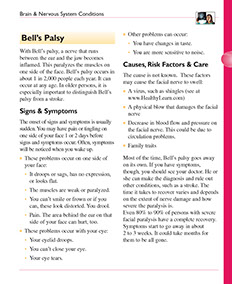CONDITIONS
SYMPTOM CHECKER
Male
Female
Child
Arm, Hand & Shoulder Concerns
Legs & Feet Concerns
Dental & Mouth Concerns
Ear & Nose
Eye Conditions
Head Conditions
Arm, Hand & Shoulder Concerns
Legs & Feet Concerns
Front
Back
Arm, Hand & Shoulder Concerns
Dental & Mouth Concerns
Ear & Nose
Eye Conditions
Head Conditions
Arm, Hand & Shoulder Concerns
Dental & Mouth Concerns
Ear & Nose
Eye Conditions
Head Conditions
Front
Back
Arm, Hand & Shoulder Concerns
Neck Links
Head & Neck Concerns
Arm, Hand & Shoulder Concerns
Neck Links
Head & Neck Concerns
Front
Back
Online Clinic
Wise Healthcare
Bell’s Palsy
Print on Demand
With Bell’s palsy, a nerve that runs between the ear and the jaw becomes inflamed. This paralyzes the muscles on one side of the face. Bell’s palsy occurs in about 1 in 2,000 people each year. It can occur at any age. In older persons, it is especially important to distinguish Bell’s palsy from a stroke.
Signs & Symptoms
The onset of signs and symptoms is usually sudden. You may have pain or tingling on one side of your face 1 or 2 days before signs and symptoms occur. Often, symptoms will be noticed when you wake up.
• These problems occur on one side of your face:
– It droops or sags, has no expression, or looks flat.
– The muscles are weak or paralyzed.
– You can’t smile or frown or if you can, these look distorted. You drool.
– Pain. The area behind the ear on that side of your face can hurt, too.
• These problems occur with your eye:
– Your eyelid droops.
– You can’t close your eye.
– Your eye tears.
• Other problems can occur:
Causes, Risk Factors & Care
The cause is not known. These factors may cause the facial nerve to swell:
• A virus, such as shingles
• A physical blow that damages the facial nerve
• Decrease in blood flow and pressure on the facial nerve. This could be due to circulation problems.
• Family traits
Most of the time, Bell’s palsy goes away on its own. If you have symptoms, though, you should see your doctor. He or she can make the diagnosis and rule out other conditions, such as a stroke. The time it takes to recover varies and depends on the extent of nerve damage and how severe the paralysis is. Even 80% to 90% of persons with severe facial paralysis have a complete recovery. Symptoms start to go away in about 2 to 3 weeks. It could take months for them to be all gone.
Self-care can help with the discomfort. For severe cases, a doctor may prescribe:
• Nerve conduction tests of the facial nerves
• Physical and/or speech therapy
• Corticosteroid medicine to reduce swelling of the affected nerve
• Eye drops to comfort and protect the affected eye
• Electric stimulation to the affected muscle
• Surgery, on occasion, to reduce pressure on the facial nerve
• Plastic surgery may be done in rare cases, if the face remains paralyzed.
Self-Care
Try to be patient. Bell’s palsy is a cause for distress, but is not dangerous. The goal of self-care is to ease symptoms and to prevent damage to the eye.
For Pain:
• Take an over-the-counter medicine for pain.
• Cover or close your eye. Apply a heating pad (set on low) to the painful area. Do this for 15 minutes at a time, 2 times a day.
• Soak a washcloth in hot water. Wring it out. Close your eye and place it on the closed eye for 15 minutes.
If You Cannot Close Your Eye:
• Wear wraparound goggles during the day to protect your eyes from dust, dirt, and dryness. Wear an eye patch at night to help hold the eyelid shut.
• Exercise the affected facial muscles as advised by your doctor or physical therapist. Do a facial massage for 15 to 20 minutes a day. With an oil or a cream, massage the muscles of your forehead, cheek, lips, and eye area.
• Use over-the-counter artificial tears as advised by your doctor.
• Keep up with your normal activities.
• Eat soft foods, if you need to.
When to Seek Medical Care
Contact Doctor When:
• You have no improvement in symptoms 3 weeks after you have been diagnosed with Bell’s palsy.
• You have any of these problems after a diagnosis of Bell’s palsy:
– Symptoms get worse.
– The numbness or weakness appear to be spreading or affect an area or body part not affected before.
– Your eye gets very red or irritated.
– Fever
– Severe pain
– Swelling or a lump in front of the ear
Get Immediate Care When:
You have signs of a stroke.
{Note: Immediate care is advised because the initial symptoms of Bell’s palsy are similar to ones of a stroke. This is especially true for older persons.}
This website is not meant to substitute for expert medical advice or treatment. Follow your doctor’s or health care provider’s advice if it differs from what is given in this guide.
The American Institute for Preventive Medicine (AIPM) is not responsible for the availability or content of external sites, nor does AIPM endorse them. Also, it is the responsibility of the user to examine the copyright and licensing restrictions of external pages and to secure all necessary permission.
The content on this website is proprietary. You may not modify, copy, reproduce, republish, upload, post, transmit, or distribute, in any manner, the material on the website without the written permission of AIPM.
2021 © American Institute for Preventive Medicine - All Rights Reserved. Disclaimer | www.HealthyLife.com
















































